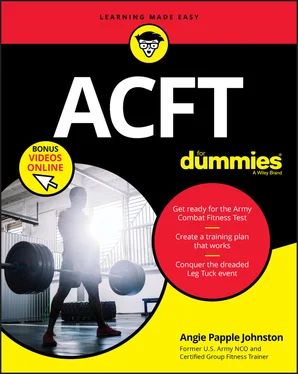1 ...6 7 8 10 11 12 ...15 The Army’s policies on taking the ACFT are considered “living documents,” which means the higher-ups can change them as necessary. Because the test is new in the grand scheme of things — the APFT dominated physical fitness for four decades — the frequency of testing may change. As of this writing, the Army expects the administration part of the ACFT to be very similar to the APFT. That means your unit can schedule a test at any time.
If you joined the Army within the last few years, you’ve probably taken an Occupational Physical Assessment Test, or OPAT. All recruits take it to see whether they’re fit to fight in certain MOSs, and even some soldiers who reclass to a different MOS are required to take it. The OPAT is entirely separate from the ACFT, but it does have some similarities. The OPAT has four physical demand categories: Heavy, Significant, Moderate, and Unqualified. (Soldiers who are reclassing to an MOS with a higher physical demand category than the one they currently have must take the test.) The OPAT requires soldiers to perform a standing long jump, a seated power throw, a strength deadlift, and an interval aerobic run. So what happens if someone fails the OPAT? If the recruit or soldier can’t eventually pass, recruiters and retention personnel may be able to renegotiate to allow him or her to enter an MOS with a lower physical demand category.
AR 350-1 says, “Commanders may administer the APFT as often as they wish; however, they must specify beforehand when the results are for record. The AA and Active Guard/Reserve (AGR) Soldiers will take the APFT at least twice each calendar year. A minimum of 4 months will separate record tests if only two record tests are given. The intent is for the Active Army and the AGR Soldiers to take a record APFT every 6 months. Mission requirements often prevent the even spacing of record tests. Therefore, commanders are encouraged to test Soldiers for record as close to the record test window as possible.”
Breaking Down the Six Events and Their Scoring
The ACFT’s six events all count toward your score. And just like the APFT, if you fail one event, you fail the whole ACFT. (No pressure, though.) You have to complete all six events, in order, on the same day, and the test can’t take more than 120 minutes. That includes the Preparation Drill and the following:
3 Repetition Maximum Deadlift, or MDL
Standing Power Throw, or SPT
Hand Release Push-Up – Arm Extension, or HRP
Sprint-Drag-Carry, or SDC
Leg Tuck, or LTK
Two-Mile Run, or 2MR
If you fail one of the events, you can’t stop taking the ACFT. You have to complete the remaining events to the best of your ability.
Each event is worth 100 points, so a perfect score is 600. Every MOS falls into one of three physical demand categories: Heavy, Significant, and Moderate. Each soldier in that MOS must meet at least the minimum score for his or her physical demand category to pass. You need a minimum of 60 points in each event for the Moderate category, 65 points for the Significant category, and 70 points for the Heavy category. Table 2-1shows the absolute minimum scores you must get in each event for each physical demand category (and you can find your MOS’s physical demand category, as well as the points awarded for each score, in Chapter 4).
TABLE 2-1Minimum ACFT Physical Demand Requirements
| Category |
MDL |
SPT |
HRP |
SDC |
LTK |
2MR |
| Moderate (Gold) |
140 pounds |
4.5 meters |
10 |
3:00 |
1 |
21:00 |
| Significant (Gray) |
180 pounds |
6.5 meters |
20 |
2:30 |
3 |
19:00 |
| Heavy (Black) |
200 pounds |
8.0 meters |
30 |
2:10 |
5 |
18:00 |
 During fiscal year 2021, soldiers only need to meet the Gold standard, regardless of MOS. The normal standards will kick in when FY22 starts; that’s when you’ll have to pass the standards for your physical demand category.
During fiscal year 2021, soldiers only need to meet the Gold standard, regardless of MOS. The normal standards will kick in when FY22 starts; that’s when you’ll have to pass the standards for your physical demand category.
Before you dive into the test, you need to know the protocols and why the Army uses them. First, you have to attempt all six events unless you have a physical profile (I cover the alternate events for profiles later in this chapter). Soldiers rotate through each lane in groups of four, but groups of fewer than four are authorized. The test has only one programmed rest period, and it’s between the Leg Tuck event and the Two-Mile Run. If only one or two soldiers are testing, the Army requires the OIC and NCOIC — the commissioned and noncommissioned officers in charge — to provide those soldiers with a five-minute rest period between each event (which they’d get anyway if more soldiers were testing).
You get no restarts on the ACFT. If you perform a repetition incorrectly, it doesn’t count — and your grader doesn’t send you to the back of the line to retest. You sign your scorecard at the test site, and your signature says you agree with the scores your grader recorded. The OIC or NCOIC resolve any discrepancies within the test’s 120-minute time limit. And although the Army allows video recording of the test, that video can only be used for training purposes. You can’t use it to argue that you performed a rep correctly or that your grader made a counting mistake.
A soldier who isn’t taking the ACFT leads the Preparation Drill — the Army’s dynamic warm-up. The Preparation Drill leader reads these instructions aloud:
You are about to take the Army Combat Fitness Test, or ACFT, a test that will measure your upper and lower body muscular endurance, muscular strength, aerobic endurance, anaerobic endurance, and explosive power. The results of this test will give you and your commanders an indication of your state of physical readiness and will act as a guide in determining your physical training needs. After selecting a lane with your preferred weight for the 3 Repetition Maximum Deadlift Event, you may be assigned to a different lane for the next events. You will rest and recover while other soldiers complete their turns. After the last soldier completes the Leg Tuck event, there will be a 10-minute recovery period for all tested soldiers before the start of the 2-Mile Run. Do the best you can on each of the events.
The Preparation Drill lasts 10 minutes, and during that time, you’re encouraged to perform the whole drill while in formation. You can skip exercises if you believe they may exhaust you or hurt your ability to perform well on the test. These are the Preparation Drill exercises, which are part of Holistic Health and Fitness, or H2F (and you thought that whole new PT program wasn’t leading up to anything!):
Bend and Reach
Rear Lunge
High Jumper
Rower
Squat Bender
Windmill
Forward Lunge
Prone Row
Bent Leg Body Twist
Push-up
After the Preparation Drill, you get to figure out which MDL weight is right for you. You can use that time to warm up by lifting the hex bars. If you choose to do so, the Army recommends doing eight to ten reps at about 25 percent of your goal weight and then resting for two minutes, six reps at 40 percent of your goal weight and resting for three minutes, four reps at half your goal weight and resting for four minutes, or one rep at 80 percent of your goal weight and resting until the MDL begins. You know your body, though, and you know what you need to do to get warmed up — don’t overdo it before the test starts because you’re feeling pumped.
Читать дальше

 During fiscal year 2021, soldiers only need to meet the Gold standard, regardless of MOS. The normal standards will kick in when FY22 starts; that’s when you’ll have to pass the standards for your physical demand category.
During fiscal year 2021, soldiers only need to meet the Gold standard, regardless of MOS. The normal standards will kick in when FY22 starts; that’s when you’ll have to pass the standards for your physical demand category.










